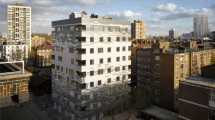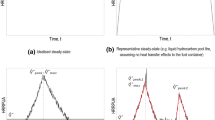Abstract
An approach to the mathematical modeling of the suppression of thermal decomposition and flaming combustion of forest fuels (FFs) is proposed which differs from the well-known approaches in that the pyrolyzed FF layer is represented as a heterogeneous structure with high porosity and the thermophysical characteristics of this layer are described using additive mathematical models of thermal conductivity, heat capacity, and density. Experimental studies of the main thermophysical characteristics (thermal conductivity, heat capacity, and thermal diffusivity) of typical FFs were performed. Mathematical modeling of heat- and mass-transfer processes under the above conditions was performed, and the suppression characteristics of the destruction reaction of a typical FF were determined using the values of thermophysical characteristics established in the experiments. The ranges of the integral characteristics of FF flame suppression with varying thermophysical characteristics of FFs within permissible limits were identified.






Similar content being viewed by others
REFERENCES
On the State of Protection of the Population and Territories of the Russian Federation from Natural and Man-Made Emergencies in 2016: State Report (VNII GOChS, Emercom of Russia, Moscow, 2017) [in Russian].
Atlas of Fire Risk in the Territory of the Russian Federation (Dizain. Informatsiya. Kartografiya, Moscow, 2010) [in Russian].
O. P. Korobeinichev, A. G. Tereshchenko, A. A. Paletsky, A. G. Shmakov, M. B. Gonchikzhapov, A. A. Chernov, L. Yu. Kataeva, D. A. Maslennikov, and N. Liu, “The Velocity and Structure of the Flame Front at Spread of Fire Across the Pine Needle Bed Depending on the Wind Velocity," Fire Sci. Technol. 771–779 (2015).
O. P. Korobeinichev, A. G. Tereshchenko, A. A. Paletsky, A. G. Shmakov, A. A. Chernov, M. B. Gonchikzhapov, D. D. Bezmaternykh, L. Yu. Kataeva, D. A. Maslennikov, and N. Liu, “The Velocity and Structure Flame Front at Spread of Fire across the Pine Needle Bed: Experiment," in Proc. of VII Int. Conf. on Forest Fire Research, Coimbra, Portugal, 2014, pp. 451–458.
A. Bottero, A. W. D’Amato, B. J. Palik, C. C. Kern, J. B. Bradford, and S. S. Scherer, “Influence of Repeated Prescribed Fire on Tree Growth and Mortality in Pinus Resinosa Forests, Northern Minnesota," Forest Sci. 63, 94–100 (2017).
G. Della Rocca, C. Hernando, J. Madrigal, R. Danti, J. Moya, M. Guijarro, A. Pecchioli, and B. Moya, “Possible Land Management uses of Common Cypress to Reduce Wildfire Initiation Risk: A Laboratory Study," J. Environ. Manag. 159, 68–77 (2015).
O. P. Korobeinichev, A. G. Shmakov, V. M. Shvartsberg, A. A. Chernov, S. A. Yakimov, K. P. Koutsenogii, and V. I. Makarov, “Fire Suppression by Low-Volatile Chemically Active Fire Suppressants Using Aerosol Technology," Fire Safety J. 51, 102–109 (2012).
N. P. Kopylov, I. R. Khasanov, A. E. Kuznetsov, D. V. Fedotkin, E. A. Moskvilin, P. A. Strizhak, and V. N. Karpov, “Parameters of Water Discharge by Aviation Means for Extinguishing Forest Fires," Pozhar. Bezopas., No. 2, 49–55 (2015).
O. P. Korobeinichev, A. G. Shmakov, A. A. Chernov, T. A. Bol’shova, V. M. Shvartsberg, K. P. Kutsenogii, and V. I. Makarov, “Fire Suppression by Aerosols of Aqueous Solutions of Salts," Fiz. Goreniya Vzryva 46 (1), 20–25 (2010) [Combust., Expl., Shock Waves 46 (1), 16–20 (2010).
S. Tsach, A. Peled, D. Penn, B. Keshales, and R. Guedj, “Development Trends for Next Generation UAV Systems," in2007 AIAA InfoTech at Aerospace Conf., Collection of Tech. Papers (2007), Vol. 1, pp. 490–503.
D. E. Calkin, C. S. Stonesifer, M. P. Thompson, and C. W. McHugh, “Large Airtanker use and Outcomes in Suppressing Wildland Fires in the United States," Int. J. Wildland Fire 23, 259–271 (2014).
A. O. Zhdanova, G. V. Kuznetsov, P. A. Strizhak, I. R. Khasanov, and D. V. Fedotkin, “On the Possibility of Extinguishing Forest and Peat Fires by Polydisperse Water Flows," Pozharovzryvobezopasnost’, No. 2, 49–66 (2015).
A. O. Zhdanova, G. V. Kuznetsov, and P. A. Strizhak, “Suppression of Thermal Decomposition of Forest Fuel by the Wake of a Water Projectile," Khim. Fiz. Mezoskop. 16 (2), 215–225 (2014).
A. M. Grishin, Mathematical Models of Forest Fires(Izd. Tom. Gos. Univ., Tomsk, 1981) [in Russian].
O. P. Korobeinichev, A. A. Paletsky, M. B. Gonchikzhapov, I. K. Shundrina, H. Chen, and N. Liu, “Combustion Chemistry and Decomposition Kinetics of Forest Fuels," Procedia Eng.62, 182–193 (2013).
A. O. Zhdanova, G. V. Kuznetsov, J. C. Legros, and P. A. Strizhak, “Thermal Conditions for Stopping Pyrolysis of Forest Combustible Material and Applications to Firefighting," Thermal Sci.21, 2565–2577 (2017).
A. F. Chudnovskii, Thermophysical Characteristics of Disperse Materials (Fizmatgiz, Moscow, 1962) [in Russian].
A. G. Shashkov, G. M. Volkhov, T. N. Abramenkov, and V. P. Kozlov,Methods of Determining Thermal Conductivity and Thermal Diffusivity (Energiya, Moscow, 1973) [in Russian].
H. S. Katz and J. V. Milewski, Handbook of Fillers and Reinforcements for Plastic (Van Nostrand Reinhold, New York, 1978).
J. A. King, K. W. Tucker, J. D. Meyers, E. H. Weber, M. L. Clingerman, and K. R. Ambrosius, “Factorial Design Approach Applied to Electrically and Thermally Conductive Nylon 6,6," Polym. Compos. 22 (1), 142–154 (2001).
R. C. Progelhof, J. L. Throne, and R. R. Ruetsch, “Methods for Predicting the Thermal Conductivity of Composite Systems: A Review," Polym. Eng. Sci. 16 (9), 615–625 (1976).
D. M. Bigg, “Thermal Conductivity of Heterophase Polymer Compositions," Adv. Polym. Sci. 119, 1–30 (1995).
A. Missenard, Conductivité Termique des Solides, Liquides, Gaz et de leurs Mélanges (Editions Eyrolles, Paris, 1965).
W. J. Parker, R. J. Jenkins, C. P. Butler, and G. L. Abbott, “Flash Method of Determining Thermal Diffusivity, Heat Capacity, and Thermal Conductivity," J. Appl. Phys. 32, 1679–1684 (1961).
R. S. Volkov, A. O. Zhdanova, G. V. Kuznetsov, and P. A. Strizhak, “Determination of the Volume of Water for Suppressing the Thermal Decomposition of Forest Combustibles," J. Eng. Phys. Thermophys.90, 789–796 (2017).
A. A. Paletsky, M. B. Gonchikzhapov, and O. P. Korobeinichev, “Molecular Beam Mass Spectrometric Study of the Pyrolysis of Forest Fuel Materials," Sibbezopasnost’-Spassib, No. 1, 97–98 (2011).
Author information
Authors and Affiliations
Corresponding author
Rights and permissions
About this article
Cite this article
Antonov, D.V., Zhdanova, A.O. & Kuznetsov, G.V. Suppression Characteristics of Flaming Combustion and Thermal Decomposition of Forest Fuels. Combust Explos Shock Waves 56, 163–171 (2020). https://doi.org/10.1134/S0010508220020070
Received:
Published:
Issue Date:
DOI: https://doi.org/10.1134/S0010508220020070




